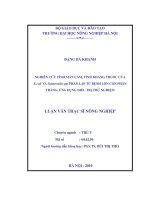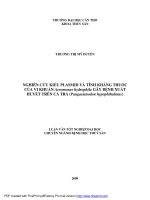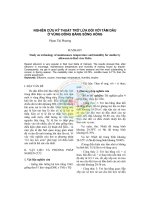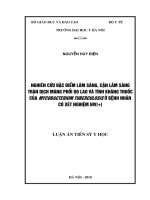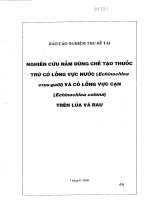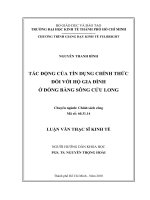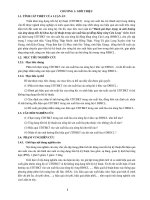Nghiên cứu tính kháng và cơ chế kháng thuốc của cỏ lồng vực nước (echinochloa crus galli) đối với hoạt chất quinclorac tại đồng bằng sông cửu long tt tiếng anh
Bạn đang xem bản rút gọn của tài liệu. Xem và tải ngay bản đầy đủ của tài liệu tại đây (1.24 MB, 29 trang )
MINISTRY OF EDUCATION AND TRAINING
CAN THO UNIVERSITY
SUMMARY OF DOCTORAL DISSERTATION
Specialization: Plant Protection
Code: 9620112
LE DUY
STUDY ON THE RESISTANCE MECHANISM OF
BARNYARDGRASS (Echinochloa crus-galli (L.) Beauv.)
TO QUINCLORAC
IN THE MEKONG DELTA OF VIETNAM
Can Tho, 2018
The dissertation was completed at College of Agriculture and
Applied biology, Can Tho University.
Scientific supervisor:
Associate Professor. PhD. Nguyen Minh Chon
Reviewer 1:..........................................................................
............................................................................
Reviewer 2:..........................................................................
...........................................................................
Reviewer 3:..........................................................................
...................................................……………..
The thesis is defended in front of the University Examination
Council in Can Tho University
Time:…………..……………
Date:…………….……………..
Further information of the thesis could be found at:
1. Learning Resource Center of Can Tho University
2. National library of Vietnam
PUBLISHED RESEARCH
1. Duy Le, C. M. Nguyen, R. K. Mann, C. N. Yerkes and B. V.
N. Kumar. 2017. Genetic diversity and herbicide resistance of
15 Echinochloa crus-galli populations to quinclorac in
Mekong Delta of Vietnam and Arkansas of United States.
Journal of Plant Biotechnology, 44: 472-477.
2. Duy Le, C. M. Nguyen, R. K. Mann, B. V. N. Kumar and
M. Morell. 2018. Efficacy of Rinskor (florpyrauxifen-benzyl
ester) on Herbicide Resistant Barnyardgrass (Echinochloa
crus-galli) in Rice Fields of Mekong Delta, Vietnam. Journal
of Crop Science and Biotechnology, 21: 75-81.
3. Duy Le, C. M. Nguyen, B. V. N. Kumar and R. K. Mann.
2018. Weed management practices to control herbicideresistant Echinochloa crus galli in rice in Mekong Delta,
Vietnam. Research On Crops , 19: 20-27.
Chapter 1: INTRODUCTION
1.1 Problem statement
The barnyardgrass (Echinochloa crus-galli) had been
considered as the most notorious for a long time, as a C4 plant, the
growth rate of barnyardgrass is far dominant to rice. In addition,
Echinochloa crus-galli and Echinochloa colona can mimic the rice
appearance at the early stage of weed seedlings and make it hard to
control by hand weeding. Herbicide is an effective solution for
controlling the barnyardgrass, however, the herbicide resistant
barnyardgrass is a critical issue to the weed management in the rice
field. The barnyardgrass could evolve resistance to several current
herbicide active ingredients. Further research about herbicide
resistance in barnyardgrass is critical. As an outcome, the
dissertation of “Study on the resistance mechanism of barnyardgrass
(Echinochloa crus-galli) to quinclorac in the Mekong Delta of
Vietnam” was proposed.
1.2 Objective of dissertation
(1) Evaluate the morphological variability and genetic
diversity of Echinochloa spp. populations in Mekong Delta of
Vietnam.
(2) Evaluate the herbicide-resistance level of Echinochloa spp.
to bispyribac, penoxsulam and quinclorac in rice fields at the
Mekong Delta of Vietnam.
(3) Explain the biochemical mechanism and the molecular
mechanism of quinclorac-resistance in Echinochloa crus-galli.
1.3 Major research topics of the dissertation
(1) Survey the rice cultivation and weed management practice
in rice fields at the Mekong Delta of Vietnam.
(2) Evaluate the diversity of Echinochloa spp. population in
rice fields at the Mekong Delta of Vietnam.
(3) Evaluate the herbicide-resistance level of the collected
Echinochloa spp. samples to bispyribac-sodium, penoxsulam and
quinclorac by dose-response screening method.
1
(4) Evaluate the efficacy of rinskor, a new herbicide against
the herbicide-resistant Echinochloa crus-galli to find new effective
herbicide for current herbicide-resistant barnyardgrass.
(5) Use RAPD analysis to evaluate the genetic diversity of
Echinochloa crus-galli populations, and the correspondence of
quinclorac-resistance and genetic distance of Echinochloa crus-galli
populations in the Mekong delta.
(6) Measure the activity of β-cyanoalanine synthase in the leaf
tissue of Echinochloa crus-galli to study the biochemical mechanism
of quinclorac-resistance in barnyardgrass.
1.4 Time and location
Time of research was from 2014 to 2018
Experiment 1; 2 and 3 was carried out at households in
College of Agriculture and Applied Biology, Can Tho University;
Experiment 4; 5 and 6 in Discovery Center of Dow AgroSciences in
Indianapolis, Indiana State, United States of America.
1.5 Novel aspects
The research has confirmed the existence of herbicideresistant Echinochloa spp. populations in Mekong Delta of Vietnam.
This research also evaluates the relationship between farmers’ weed
management practice and the herbicide-resistance, therefore, the
practical solutions for herbicide-resistant weed were also determined
and suggested in the dissertation.
The mechanisms of quinclorac-resistance in barnyardgrass
were confirmed and elucidated at enzyme and molecular level,
through the measurement of quinclorac detoxifying enzyme activity
and its gene expression level in barnyardgrass. The results establish
important information for the further study about the mechanism of
the herbicide-resistance in weeds.
1.6 Layout
The dissertation consists of 102 pages (21 tables, 38 pictures
and 202 references). In that, introduction: 3 pages, background: 33
pages; materials and methods: 18 pages; results and discussion 43
pages; conclusions and suggestions: 2 page; reference: 18 pages;
appendix 42 pages for both mumber and pictures.
2
Chapter 2: BACKGROUND OF DISSERTATION
The genus Echinochloa includes over 250 species, and most
of these are considered as weeds. The barnyardgrass (Echinochloa
spp.) is C4 monocots and originated from Europe and has been now
documented worldwide. The morphology of Echinochloa spp. is
highly diverse, in many cases, there are several species confused
with one another. In Asia, rice fields have three main barnyardgrass
species, Echinochloa crus-galli, Echinocloa colona, and
Echinochloa glabrescens, which found in Vietnam.
The bispyribac and penoxsulam are two popular ALS inhibitor
herbicide on rice, those two herbicide is mainly used for
barnyardgrass control in Vietnam. Quinclorac is a synthetic auxin
herbicide, and the product contains quinclorac is wide used for
controlling barnyardgrass in the rice field. Rinskor is a new synthetic
auxin herbicide, and this herbicide is not used for weed management
in Vietnam when the dissertation started in 2014.
The weed seed of 78 populations of Echinochloa spp.
collected from rice field in 7 provinces of the Mekong Delta of
Vietnam, the seedling from collected seed was tested with
bispyribac, penoxsulam, quinclorac and rinskor to evaluating the
LD90 and herbicide resistance level. To continue the study on the
mechanism of resistance, 15 selected weed populations were
selected for genetic distance analysis by using the RAPD method.
The activity of cyanoalanide synthase was analyzed to evaluate the
enzyme level in leaf of 5 different weed populations under the
treatment of quinclorac. Finally, the expression level of mRNA of
cyanoalanide synthase in 5 populations was measured by the
comparative methods of 2−ΔCt, the activity of enzyme and the
expression level of mRNA in the 5 populations was analyzed to find
the association of two value, the result of this research was used to
supporting the study of herbicide mechanism of quinclorac in
barnyardgrass.
3
CHAPTER 3: MATERIALS AND METHODS
3.1 Experiment 1. Survey on farmer practice in rice cultivation
and weed management in the Mekong Delta
Target of research: Study on the farmer practice of weed
management on the rice field in Mekong Delta of Vietnam
Barnyardgrass seed sample was collected from total 90 rice
field, after germination test in greenhouse, 78 quality samples were
selected for further experiments. During the weed seed sample
collecting on the field, the researcher had interviewed the field
owner about the cultivation practice in the field, the questions were
included 9 questions about:
- Number of rice seasons per year
- Field size that he/she is growing rice (hectare)
- Number of herbicide application per season
- Condition of water management
- Perception about the important weed species in rice field
- Most popular herbicides used for controlling barnyardgrass
- Cost for weed management per hectare per season
- Cost for herbicide per hectare per season
- Cost for hand-weeding per hectare per season
The questions were designed to get essential information
about the field condition, and the weed management practice of the
field owner, the questions were asked after seed sample collected,
there were 17 seed samples collected without input from farmer.
Statistical analysis
After cross-check, the inputs with unreliable information or
unclear data were excluded from the final analysis, final answer
from 71 farmers were processed for analysis.
Collected data were analyzed using ANOVA with mean
comparison by Tukey-Kramer test at α=0.05. One way ANOVA ttest with p<0.05 was used for analyzing the mean of field size and
hand-weeding. The analysis was run by statistical software JMP Pro
13 (SAS).
4
3.2 Experiment 2. Classification of the collected Echinochloa
spp. populations based on plant characteristics
Target of research
Classify the collected Echinochloa spp. populations based on
reported taxonomy keys, the purpose of this research is to generate
the initial information about the diversity of Echinochloa spp.
populations in Mekong Delta, before conducting further research of
herbicide-resistance mechanism in barnyardgrass (Echinochloa crusgalli) species.
The descriptions about species of Echinochloa spp.
morphology of Pignatty’ key and Carretero’s key - validated by
Tabacchi et al. (2006) (Appendix M), Heap (2017) and USDA
(2017) were used to identify the species of collected samples,
observations of morphology are included: (1) Plant height: measure
from the basal to the top leave at 56 day after germination; (2) Plant
weight: the plant dry biomass (above the soil) at 56 day after
germination, the plant collected and dried down under sunlight for 7
days, until the weight of plant not change; (3) Color of basal:
observe the color basal of seedling, the color was red or green for
collected sample; (4) Number of node: the nodes were count at 56
day after germination; (5) Panicle emerged time: the duration from
germination until the first flower fully opened; (6) Grow duration:
the duration from seed germination until all the seed ripen; (7)
Morphology of flower: The photo of the flower and seed was taken,
then used for reference of species identification; (8) In order to
minimize the possibility of using incorrect species in further assays
of enzyme and molecular analysis. The information of weed species
was used for selection of candidate populations in the test of
population genetic diversity, enzyme activity and gene expression
under effect of quinclorac.
Statistical analysis
Collected data were analyzed using ANOVA with mean
comparison by Tukey-Kramer test at α=0.05. One way ANOVA ttest with p<0.05 was used for analyzing the means. The analysis was
run by JMP Pro 13 (SAS).
5
3.3 Experiment 3: Evaluate the herbicide-resistance level in
collected Echinochloa spp. populations to 3 active ingredients of
bispyribac-sodium, penoxsulam and quinclorac
by doseresponse screening method
Target of research
Use dose-response screening method to identify the herbicideresistant and herbicide-susceptible barnyardgrass populations in
Mekong Delta, and evaluate the herbicide-resistance level of those
populations to 3 active ingredients of bispyribac, penoxsulam and
quinclorac.
Herbicide-resistance level evaluation
At the 3-4 leaf stage of barnyardgrass, the weed seedlings
were treated by foliar application of 3 herbicides, included
bispyribac (10% SC formulation), penoxsulam (2.5% OD) and
quinclorac (25% SC formulation) at 6 doses range of 0.25X, 0.5X,
1.0X, 2.0X, 4.0X and 8.0X, the X dose is label dose of each
herbicide products, in which bispyribac was 25 g a.i/ha, penoxsulam
was 12.5 g a.i/ha, quinclorac was 250 g a.i/ ha.
The experimental design was a complete randomized design
(CRD), with 4 replications, one pot per replication and 10 plants per
pot, the number of plants in pot was manually controlled.
Herbicide application was made in a spray booth (Research
track sprayer SB-8, Devries Manufacturing), pressure was calibrated
to deliver 300 L ha−1 at 140 kPa. At 14 day after treatment (DAT),
the mortality rate was assessed by counting the number of surviving
and completely killed plants. The results of dose response were used
for calculating the LD90 for each population by non-linear regression
model using GraphPad Prism 7.02 (San Diego, CA) software. The
solo-resistance and multiple-resistance of tested herbicides was
calculated based on the response of weed population to the specific
herbicide, the detail of calculation as described in below statistical
analysis section.
6
Statistical analysis
Mortality and herbicide rate were fitted into a four parameters
logistic curve:
𝑎−𝑏
𝑦=𝑎+
(𝑙𝑜𝑔
𝐿𝐷90−𝑥)∗𝑒
1 + 10
Y: mortality rate; X: quinclorac rate; LD90: estimated dose that kill
90% weed population; a: lower limit; b: upper limit; e: slope around
LD90
The herbicide-resistance level rating based on % of
barnyardgrass controlled at label dose, and R rating scale was based
on descriptions of Moss et al. (2007), where control efficacy at label
dose of susceptible (S) is 81-100%; R? (suspected resistance) is 7280%; RR is 36-71% and RRR is 0-35%. Values of LD90 were
considered to be statistically different if the respective 98%
confidence interval did not overlap. The correlation between
candidate factors analyzed by using regression and Pearson’s
correlation analysis. Regression analysis and regression graph were
performed by JPM Pro 13 software (SAS).
3.4 Experiment 4: Evaluate the efficacy of rinskor as new
herbicide in herbicide resistance barnyardgrass populations
Target of research
After the herbicide screening test of bispyribac, penoxsulam
and quinclorac, all 78 barnyardgrass populations were treated by
rinskor 2.5% at 6 doses of 0.25X, 0.5X, 1.0X, 2.0X, 4.0X and 8.0X,
the 1.0X dose was 25 g a.i/ha. The % mortality of weed was
assessed at 14 days after application.
The results of this test also served for the recommendation of
effective herbicide solution for current herbicide-resistant
barnyardgrass in Mekong Delta.
Statistical analysis
The method for LD90 calculation and herbicide-resistance
level was similar to method described in Experiment 3.
7
3.5 Experiment 5: Compare the activity of enzyme βcyanoalanine (CAS) in quinclorac-susceptible and quincloracresistant barnyargrass plant to study biochemical mechanism of
quinclorac-resistance in barnyardgrass
Target of research
Plant tissue bioassay to measure the expression level of βcyanoalanine from survived plants of screening test to determine the
resistance level of populations to quinclorac
Select candidate barnyardgrass populations and herbicide
treatment
Five barnyardgrass populations that exhibited most reliable
herbicide-resistance or herbicide-susceptible was selected for the
enzyme assay, the candidate plants at 3-4 leaf stage were treated by
quinclorac at 125 g a.i/ha (half of label dose to ensure the herbicide
treatment will not kill the susceptible plant during assessment).
The herbicide spraying was done in a spray booth (Research
track sprayer SB-8, Devries Manufacturing), pressure was calibrated
to deliver 300 L ha−1 at 140 kPa. The indica rice variety IR50404 at
3-4 leaf stage was also treated by quinclorac, the rice sample was
used as reference sample for the enzyme analysis, one quincloracresistant population and one quinclorac-susceptible population
originated from rice field of Arkansas State of United of America
was used as comparison for the populations in the study.
Determine CAS activity in leaf tissue
The activity of CAS enzyme in barnyardgrass leaf tissue was
analyzed based on described method of Chon et al. (2008):
- One gram of fresh leaves from 4 plants in each population
were collected at 1 hour and 3 days after herbicide treatment.
- Leaf samples were pooled and frozen rapidly in liquid
nitrogen before being homogenized with TissueLyzer II
(Qigen), plant tissue was homogenized at 30 strokes per
second for 1 minute, this process was repeated 2 times after
switching orientation to ensure uniform mixing and tissue
particle size.
- Centrifuged at 10,000 g for 10 min at 4oC.
8
- Then 2.5 mL of 100 M Tris buffer (pH=8.5) was added into
microtubes containing homogenized 1 g of homogenized leaf
tissue.
- The supernatant was used for enzyme assay.
- 100 mM Tris buffer (pH=8.5) was used to make 2 solutions of
25 mM NaCN and 5mM L-cysteine.
- NaCN and L-cysteine, supernatants, were equilibrated for 10
minutes at 30oC, mixed with 0.5 ml of enzyme extract, 2 ml of
NaCN, 2 ml of L-cysteine in a sealed tube and incubated at
30oC for 60 min.
- After the incubation, 1 ml aliquot of solution was transferred
to a microfuge tube that contained 0.1 ml of 0.03 M FeCl3 in
1.2 N HCl followed by 0.1 ml of 0.02 M N,N-dimethyl-pphenylenediamine sulfate in 7.2 N HCl.
- Samples were left in dark for 20 min and then centrifuged at
1020 g for 5 minutes to precipitate proteins.
- The reduction of methylene blue by hydrogen sulfide was
used to determine the level of CAS activity in leaf tissue.
- Enzyme activity was determined by reading absorbance of
methylene blue at A650 nm in a microplate reader and Na 2S
was used as the standard reference
- Enzyme activity was expressed in nmol H2S/g fresh
weight/min. Each biotype contained 4 biological replicates.
Statistical analysis
The enzyme assay was conducted as completely randomized
designs, with 4 replications per population. Data from 4 repeated
tests were pooled for analysis, the Tukey-Kramer Test was used for
multiple mean comparison at α=0.05. The tests was conducted using
JPM Pro 13 (SAS) statistical software.
3.6 Experiment 6: Identify genetic variation among quincloracresistant and quinclorac-susceptible Echinochloa crus-galli
populations in the Mekong Delta
Target of research
The Random amplified polymorphic DNA (RAPD) technique
was used to evaluate the genetic variability between different
9
populations to provide value information of the popularity and the
distribution pattern of quinclorac-resistant weed in Mekong Delta.
Plant materials
From the results of morphology study, seeds of 15
Echinochloa spp. populations were selected, the selection based on
the weed group and quinclorac-resistance level, four populations of
each group were selected, only choose the populations exhibited
reliable data of quinclorac-resistance or quinclorac-susceptible for
the test. Plant was grown in greenhouse condition, and leaves from
one represented plant in each population was collected at 3-4 leaf
stage.
Genomic DNA extraction
Genomic DNA was isolated from leaf tissue using the
DNAzol Reagent protocol (CAS No. 593-84-0, Invitrogen, Thermo
Scientific Corp., Waltham, MA) as followed steps:
- Fresh leaf tissue (1 g) from one represented plant in each
population was collected and powdered in liquid nitrogen to
prepare for DNA extraction.
- Each sample was powdered by mortar and pestle, the
homogenized sample (100 mg) was transferred to a
microcentrifuge tube containing DNAzol (1.5 mL) and
RNAse (150 µL).
- The solution was mixed and shaked for 5 min at 25oC.
- Chloroform (900 µL) was added to the solution and mixed
thoroughly for 5 min at 25oC.
- The homogenates were centrifuged at 12,000 x g for 10 min,
and the aqueous phases were transferred to new tubes.
- The aqueous phase was mixed with 100% ethanol (700 µL) to
precipitate the DNA.
- The tubes were inverted 6-8 times, held at room temperature
(25oC) for 5 min, and then centrifuged at 5000 x g for 4 min to
pellet the DNA.
- The DNA pellets were washed first in a 1:0.75 (v/v) solution
of DNAzol and 100% ethanol (900 µL) by gentle vortexing
for 10 s.
10
-
The DNAzol wash solution was then removed and 75%
ethanol (700 µL, prepared with nuclease-free water) was
added to the DNA pellets for a second wash step.
- The mixture was centrifuged at 5000 x g for 4 min.
- The ethanol wash was decanted and the pellets air dried for 12 min.
- DNA sample was solubilized in 50 µL TE buffer, pH 8.0.
- DNA concentration and purity were determined by
spectrophotometric measurement via a NanoDrop instrument
(Thermo Scientific Corp, USA).
Random Amplified Polymorphic DNA (RAPD)
amplifications
Forty 10-base pair (bp) oligonucleotide primers (synthesized
by Integrated DNA Technology, Inc., Coralville, IA) were used for
RAPD analysis.
All primers were screened on the genomic DNA of the 15
Echinochloa spp. populations and evaluated for repeatability, high
resolution and polymorphism. The PCR master mix contained 2.7
µL ddH20, 1 µL PCR buffer (Invitrogen Cat. No. 18067-017), 80 µL
MgCl2, 5 µM primer, 0.25 µL template DNA, 0.05 µL Taq
polymerase (0.5 units), and 1 µL dNTP.
The amplification protocol was carried out in a LightCycler
480 II (Roche Molecular Diagnostics, Indianapolis, IN) using the
following steps:
- Initial hold at 94oC for 2 min
- Followed by 45 cycles of 94oC for 45 s (ramp rate 4.8oC/s),
- 38oC for 5 min (ramp rate of 2.5oC/s)
- 72oC for 2 min (ramp rate 4.7oC/s), and a final hold of 72oC
for 7 min.
- Final PCR products were analyzed by LabChip GXII
(PerkinElmer, Waltham, MA).
Statistical analysis
Genetic distance and cluster analyses were conducted for 15
Echinochloa crus-galli populations using the PCR products of 6
11
informative primers. For each sample, bands were scored as present
(1) or absent (0). The similarity matrix was calculated based on
Simple Matching Coefficient (SMC) (Sneath & Sokal 1973).
Genetic distance was calculated by the following formula: 1-SMC.
We used the NT-SYS 2.1 program to run a cluster analysis to
construct an unweighted pair group method average (UPGMA)
dendrogram.
3.7 Experiment 7: Measure mRNA expression level of CAS gene
in
quinclorac-resistant
and
quinclorac-susceptible
barnyardgrass
Target of research
Measure the expression level of mRNA of CAS gene in
selected barnyardgrass and rice plant to understand about the
mechanism of the difference in CAS enzyme activity of resistant and
susceptible plant.
RT-qPCR assay design
Two sets of primers and probes amplifying each gene were
designed based on known sequences of β-cyanoalanine synthase
(LOC100682425) of Triticum aestivum (wheat) and β-Actin
synthase (HQ395760.1) of Echinochloa crus-galli in database of
National Center for Biotechnology Information, U.S
All probes were designed using a FAM fluorophore and were
run in singleplex reactions. A 10 µL total volume reaction contained
1.8 µL PCR grade H20, 5.0 µL Roche Probes Master Mix
(11636103001) (Roche), 0.4 µM of Forward Primer 0.4 µM of
Reverse Primer, 0.2 µM Probe and 2.0 µL of the 1:2 diluted cDNA.
384 Roche well plates were used for all qPCR reactions in Roche
Light Cycler 480II. The PCR reactions were conducted (Table 3.2).
Table 3.2 Steps in PCR reactions
Step
Enzyme Activation
Denature
Anneal
Extend
Cool
Temperature
95oC
95oC
60oC
72oC
45oC
12
Duration
10 minutes
10 seconds
35 seconds
1 seconds
1 seconds
Cycles
1
40
1
The main mechanism of quinclorac-resistance in
barnyardgrass is non-target site resistance, and there is limited
information about the sequence data of barnyardgrass, therefore the
DNA sequencing of target gene in quinclorac-resistance and
quinclorac-susceptible plant would not useful to clarify the
resistance mechanism(s).
We used comparative methods of 2−ΔCt to calculate the
expression of CAS gene (Livak and Schmittgen, 2001), the β-Actin
was used as the reference gene. To monitor genomic DNA
contamination, to a no-RT (NRT) reaction was run on each sample.
Statistical analysis
For the determination of CAS gene expression, four biological
replicates were used per group. The LC480 software (LightRoch)
used for managing the transcription data and build the graphs in
study. Statistical analyses were carried out using JMP Pro 13 (SAS
software) using Student’s t-test comparing non-treated groups to
quinclorac treated groups within each population.
In order to determine if the quinclorac treatment altered the
expression of the reference gene, β-Actin, the βActin Ct value
transformed to a linear value using the equation 2-Ct (Livak and
Schmittgen, 2001)and then compared non-treated group to
quinclorac treated group per population using a Student’s t-test with
p<0.05 being significant.
Chapter 4 RESULTS AND DICUSSIONS
4.1 Experiment 1. Herbicide application practice and weed
management in rice field at Mekong Delta
4.1.1 Rice cultivation practice
The number of average rice season per year in studied
locations was 2.7 rice cycle, the average size of rice field in these
provinces was 1.5 ha per field. Average number of herbicide
application per season was 2.3 in average and the average score of
water management in 7 provinces was 2.2 which mean the water
management in this area was good for weed management.
13
Table 4.1: Herbicide management practice of farmer in Mekong
Delta
Province
An Giang
Can Tho
Hau Giang
Kien Giang
Long An
Tien Giang
Vinh Long
Average
F
CV(%)
Season
per year
2.3c
2.5bc
2.7abc
3.0a
3.0a
3.0a
3.0a
2.7
*
14.5
Field
(ha)
1.6bc
0.9c
1.1c
2.3ab
2.9a
1.3c
0.7c
1.5
*
46.4
Herbicide app
per season
2.2ab
2.2ab
2.5ab
2.5ab
2.7a
2.0b
2.1ab
2.3
*
25.4
Water
management*
2.5
1.9
2.2
2.2
2.1
2.8
2.2
2.2
ns
29.7
1=easy, good land leveling and water supply, farmer can actively control the water
in the field, 2=moderate, good land leveling and water supply, soil texture is not
good for standing water, 3=difficult, uneven field surface, difficult to control water
level in the field; Means followed by the same letter are not significantly different at
P=0.05 (Tukey-Kramer multiple comparison procedure).
4.1.2 Important weed species in the rice field at seven provinces
of the Mekong Delta
Table 4.3 Farmer response about most frequently escaping weed
after herbicide treatments and need hand-weeding to control
Weed species
Number of response
Echinochloa spp.
Fimbristylis miliacea
Leptochloa chinensis
Cyperus spp.
Broadleaf weeds
Total
26
12
12
7
4
71
Most important weed
(%)
42.6
19.7
19.7
11.5
6.6
100%
Barnyardgrass (Echinochloa crus-galli) was the most
important grass weed in rice fields of this study, because this weed
biomass is the highest compared to other weed, and Echinochloa
spp. was also tolerant to herbicides, especially under difficult water
management condition. The weeds would germinate in several
flushes after rice seeded and make the control of this weed was more
challenge.
14
4.1.3 Weed escaped controlling and the cost on weed
management in the Mekong Delta
The average cost of weed management in Mekong Delta was
2,740,000 VND per season (Table 4.5). The total cost included
990,000 VND for herbicide and 1,750,000 VND for hand-weeding.
If converted to expense per hectare, the cost for herbicide and handweeding was 654,000 VND and 1,330,000 VND, respectively.
Table 4.5 The cost for weed management in Mekong Delta
Nam
e
AG
CT
HG
KG
LA
TG
VL
Avg
F
CV(
%)
Cost for
weed
manage
ment
2.75ab
2.05b
1.93b
2.99ab
4.11a
3.36ab
1.83b
2.74
*
Cost
per
hectar
e
1.79ab
2.27ab
1.8b
1.34b
1.41b
2.94a
2.35ab
1.99
*
Cost of
herbici
de/seas
on
1.05abc
0.66bc
0.89abc
1.34ab
1.39a
1.06abc
0.51c
0.99
*
16.5
11.3
17.8
0.59ab
0.73ab
0.82a
0.59ab
0.48b
0.715ab
0.64ab
0.65
*
Cost for
handweedin
/season
1.7
1.38
1.03
1.65
2.72
2.29
1.34
1.75
ns
Cost for
handweeding
/ha
1.20ab
1.53ab
0.98b
0.75b
0.93b
2.23a
1.71ab
1.33
*
5.4
9.6
9.2
Cost for
herbicid
e/ha
AG: An Giang, CT: Can Tho, HG: Hau Giang, KG: Kien Giang, LA: Long An,
TG:Tien Giang, VL: Vinh Long
Number presented as 1,000,000 VND; Means followed by the same letter are not
significantly different at P=0.05 (Tukey-Kramer multiple comparison procedure)
4.2 Experiment 2. Morphology and distribution of Echinochloa
spp. in the Mekong Delta
Plant characteristics
The average height of group 2 was 134.6 cm, this is the tallest
group among three. Height of group 1 and group 2 were not different
at 107.4 cm and 113.6 cm. Aligned with the PH, dry shoot weight of
group 2 was also highest. Panicle of group 2 also emerged later than
the others two groups. Longer growth duration was also observed in
group 2, average growth duration of this group was 93.4 days,
significantly higher than group 1 (80.9 days) and similar to group 3
15
(87.6 days). There was no difference between the numbers of node
in 3 groups, the average node number was 6.3-6.7 nodes per plant at
maturity stage.
Table 4.6 Plant characteristic of Echinochloa spp. collected in
Mekong Delta
N
Group 1
Group 2
Group 3
F
CV (%)
41
25
12
Basal
color
Red
Green
Green
-
PH
(cm)
107.4b
134.6a
113.6b
*
9.8
SDW
(g)
14.2b
20.9a
16.4b
*
14.9
PE
(day)
49.2b
53.1a
47.3b
*
11.6
GD
(day)
80.9b
93.4a
87.6ab
*
8.1
ND
(number)
6.3
6.7
6.7
ns
7.5
Means followed by the same letter are not significantly different at P=0.05 (TukeyKramer multiple comparison procedure); PH (Plant height); SDW (Shoot dry
weight), PE (Panicle emerged), GD (Grow duration), BC (Basal color), ND
(node)
4.3 Experiment 3. Herbicide resistant Echinochloa spp. in the
Mekong Delta
4.3.1 The solo resistance and multiple resistance in Echinochloa
spp. populations
Table 4.10 Percent of barnyardgrass population resistant to single
and multiple herbicides of bispyribac, penoxsulam and quinclorac in
different provinces
Bis
Pen
Quin
Bis-Pen
Bis-Quin
Pen-Quin
Bis-PenQuin
N
% sample
RR and RRR (%)
Hau
Kien
Long
Giang Giang
An
5.8
0.00
14.2
17.6
20.0
14.3
11.7
20.0
14.3
35.2
0.00
0.0
5.8
20.0
28.5
17.6
20.0
0.0
An
Giang
0.0
16.6
33.3
16.6
16.6
16.6
Can
Tho
12.5
6.2
31.2
0.0
18.7
6.2
0.0
25.0
5.8
20.0
12
50
16
87.5
17
89.4
5
80
Tien
Giang
16.7
16.7
16.7
16.7
0.0
0.0
Vinh
Long
0.0
50.0
50.0
0.0
0.0
0.0
28.6
33.3
0.00
7
87.5
6
60
4
33.3
Herbicide resistance barnyardgrass was found in all 7
provinces in the study, the collected weed in each provinces evolved
16
to at least one herbicide in the test, the percent of herbicide resistant
population was 33.3% to 89.4% in the region. The cross-resistance
and the multiple-resistance also detected in many locations of 7
provinces.
4.3.2 Correlation between field size and hand weeding
In our research, the field size did impact to hand-weeding
practice of farmer in Mekong Delta (analyzed by one way ANOVA
t-test with p<0.05), the farmer with larger field tended to do less
hand-weeding compared to farmer who cultivating on a smaller field
(Figure 4.7). There was 31 out of 76 farmers got the field >1.5 ha.
67.7% of them would not do hand-weeding in the field after
herbicide application, the labor cost of hand-weeding in large field
should be main concern that impact the decision for hand-weeding.
Figure 4.7 One way ANOVA t-test for field size and hand-weeding
practice
4.3.3 The impact of hand-weeding to herbicide resistance of
Echinochloa spp. in the Mekong Delta
The Resistance Score of field without hand-weeding was
significantly higher than the other group with hand-weeding (Figure
4.8), average resistance scale of 15 fields without hand-weeding was
4.8 compared to 3.1 of field treated by hand-weeding after herbicide
application.
17
Figure 4.8 One way ANOVA t-test for the impact of hand-weeding
to herbicide resistance in rice field
4.4
Experiment 4. Weed control efficacy of rinskor in
Echinochloa spp. in the Mekong Delta
4.4.1 Control efficacy of rinskor as a new herbicide against three
Echinochloa spp. groups collected in the Mekong Delta
Table 4.13 Average LD90 of barnyardgrass population to bispyribac,
penoxsulam, quinclorac and rinskor
An Giang
Can Tho
Hau Giang
Kien Giang
Long An
Tien Giang
Vinh Long
Average
F
CV(%)
Bispyribac
23.3b
34.0ab
36.4a
40.3a
35.9a
27.2b
34.4ab
33.1
*
34.9
LD90 (g a.i/ha)
Penoxsulam
Quinclorac
11.9
495ab
16.5
844a
16.7
545ab
14.7
384ab
16.1
593ab
13.0
341b
16.1
439ab
15.1
520.2
ns
*
38.8
93.2
Rinskor
19.3
15.6
17.9
17.8
18.8
16.4
15.1
17.1
ns
43.4
Means followed by same letter are not different at p<0.05 (protected by TurkeyKramer multiple mean test)
*: significant difference at 5% level, ns:no significant difference
Label dose of tested herbicides: bispyribac at 25 g a.i/ha; penoxsulam at 12.5 g
a.i/ha; quinclorac at 250 g a.i/ha; rinskor at 25 g a.i/ha
The LD90 of rinskor in the tested populations ranged from 15.1
to 19.3 g a.i/ha. The mean value of LD 90 for rinskor was not different
18
between weed populations in the sampled areas, with an average
LD90 being 17.1 g a.i/ha (Table 4.13).
4.4.2 Efficacy of bispyribac, penoxsulam and quinclorac in
susceptible Echinochloa crus-galli compared to resistant plants
Efficacy of bispyribac, penoxsulam and quinclorac on
resistant Echinochloa crus-galli was reduced compared to efficacy
on susceptible plants. The recommended dose of three herbicides
offered 91.3-100% control of susceptible plants, but only controlled
40.7-53.3% of resistant plants. Dose response was low at higher
dose, at the 4 folds of quinclorac label dose, the weed control
efficacy was increased 6% compared to the doubled dose.
Table 4.15 Mortality of susceptible (S) and resistant barnyardgrass
treated by different dose of bispyribac, penoxsulam and quinclorac
% mortality at different herbicide dose
Doseφ
Product
Bispyribac-S
Penoxsulam-S
Quinclorac-S
Bispyribac-R
Penoxsulam-R
Quinclorac-R
F
CV(%)
0.25X
0.5X
1.0X
2.0X
4.0X
8.0X
20.3a
27a
22.6a
4.6b
8.3b
5.0b
43.7b
52.7ab
64.3a
10.3c
17.0c
18.7c
91.3a
97.3a
98.3a
51.7b
40.7b
53.3b
99.3a
99.0a
100.0a
74.3b
63.3b
81.3b
100.0
100.0
100.0
88.0
94.0
88.0
100.0
99.7
100.0
97.0
99.7
98.0
*
*
*
*
ns
ns
7.2
5.7
10.2
6.9
5.2
4.1
φ
0.25X=25% of label dose; 1X=label dose; 8.0X=800% of label dose. Means
followed by same letter are not different at p<0.05 (protected by Turkey-Kramer
multiple mean test); Label dose or 1X dose of tested herbicides: bispyribac at 25 g
a.i/ha; penoxsulam at 12.5 g a.i/ha; quinclorac at 250 g a.i/ha; rinskor at 25 g
a.i/ha
4.4.3 Efficacy of rinskor for control of susceptible or resistant
barnyardgrass to bispyribac, penoxsulam and quinclorac
The efficacy of rinskor in Echinochloa crus-galli populations
susceptible to bispyribac, penoxsulam and quinclorac is presented in
19
Table 4.16. The selected weed populations exhibited high
susceptibiliy to rinskor in this study. The 1.0X dose resulted in
94.3% to 100% weed mortality. At doses of 1.0X to 8.0X of rinskor,
there was no difference between the 6 populations, and it implied
that rinskor at label dose could effectively control the Echinochloa
crus-galli regardless of the resistance levels to bispyribac,
penoxsulam and quinclorac, meanwhile it was required 8X of label
dose of the bispyribac, penoxsulam and quinclorac to exhibit >90%
control of the resistant weeds, which is unlikely practical in the
reality due to cost-effectiveness.
Table 4.16. Mortality of herbicide susceptible (S) and herbicide
resistant (R) barnyardgrass treated by rinskor at different dose
% mortality at different herbicide dose
φ
Dose
Product
Rinskor_Bispyribac-S
Rinskor_Penoxsulam-S
Rinskor_Quinclorac-S
Rinskor_Bispyribac-R
Rinskor_Penoxsulam-R
Rinskor_Quinclorac-R
F
CV(%)
0.25X
0.5X
1.0X
2.0X
4.0X
8.0X
31.0a
26.3ab
27.3ab
33.0a
18.0b
17.3b
84.0a
83.7a
84.3a
81.7a
70.0b
76.0b
100.0
98.0
96.3
95.7
94.3
98.3
100.0
100.0
100.0
100.0
100.0
100.0
100.0
100.0
100.0
99.3
100.0
100.0
100.0
100.0
100.0
100.0
100.0
100.0
*
*
ns
ns
ns
ns
11.4
8.4
8.1
0
4.4
0
φ
0.25X=25% of label dose; 1X=label dose; 8.0X=800% of label dose. Means
followed by same letter are not different at p<0.05 (protected by Turkey-Kramer
multiple mean test); Label dose or 1X dose of tested herbicides: rinskor at 25 g
a.i/ha
4.5 Biodiversity study by RAPD analysis in 15 barnyardgrass
populations from Vietnam and the U.S
RAPD analysis of 15 barnyardgrass populations
Among the 40 oligonucleotide primers screened, six primers
which produced polymorphic bands and showed repeatable results,
those 6 primers were selected for the analysis. Six primers were OPE01, OP-H02, OP-N07, OPH02, DAS04 and DAS08 (Table 4.17).
20
These primers produced 55 bands, ranging from 50 to 1367bp;
average number of polymorphic bands was 7.7 and per primer.
Table 4.17 Six informative primers in RAPD analysis of
Echinochloa crus-galli populations*
No
Name
Sequence
5’-3’
1
2
3
4
5
6
N
OP-E01
OP-H02
OP-N07
OP-K20
DAS04
DAS08
CCCAAGGTCC
TCGGACGTGA
CAGCCCAGAG
GTGTCGCGAG
TGAGGAGGAG
AACGTCTGCC
Number
of
amplified
8
bands
10
9
9
10
9
55
Number of
polymorphic
band
7
9
6
8
10
6
46
Percent of
polymorphic
band
87.5 %
90.0 %
66.7 %
88.9 %
100.0 %
66.7 %
-
*Primers 1-3 were cited from Rutledge et al. (2000), primer 4 was cited in Kil-Ung
et al. (1998), and primers 5-6 were randomly generated.
Figure 4.11 The dendrogram of 15 Echinochloa crus-galli
populations from Vietnam (CT-10, KG-01, TG-03, HG-06, HG-02,
CT-08, HG-03, CT-04, VL-03, HG-01, CT-02, CT-01, VL-01) and
U.S (A-S, AR)
The diagram constructed by unweighted pair group method average (UPGMA) and
genetic distance calculated by 1-SMC formula.
21
a
a
c d cd de
e
c d cd d
bc c c c
c
c
bc
b
b
a a
b
b
c
Oryza sativa
1)
CAS activity (nmol H2S-1 100 ug-1 minute-
4.6 Biochemical mechanism and molecular mechanism of
quinclorac resistance in barnyardgrass
4.6.1 B-CAS activity in 5 quinclorac resistant barnyardgrass
populations
At 3 days after herbicide treatment the enzyme activity in two S
population Ech_01 and Ech_02 were 1.1 and 2.5 nmol H2S/100 ug/
minute or equal to 34% and 18% increase over the control sample.
The CAS activity in three R populations were increased 45% and
74% as compared to the control, the enzyme production in the two
highest resistant populations Ech_04 and Ech_05 were 951% and
1873% higher than the susceptible weed Ech_01, which confirmed
that those R populations were more capable to detoxify quinclorac
than the two populations in the S group.
1h control
1h treated
3d control
3d treated
Figure 4.15 Activity of enzyme CAS (nmol H2S/100ug/minute) in
barnyardgrass leaf tissue treated by quinclorac. Data collected
at 1 hour and 3 days after treatment.
Data were analyzed using Student’s t-test comparing non-treated to quinclorac
treated groups within each population with p<0.05 being significant (n=4 per
group). Data are graphed as mean + SEM. Significance between treated and
untreated within a population is indicated by *.
22
